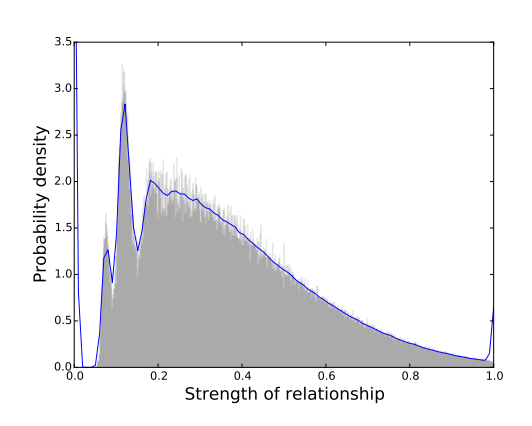
Your Brain Limits You to Just Five BFFs
Back in the 1990s, the British anthropologist Robin Dunbar noticed a remarkable correlation between primate brain size and the social groups they formed. This correlation was simple: the bigger their brains, the larger their social groups. And the explanation seemed reasonable: animals with bigger brains can remember, and therefore interact meaningfully with, more of their peers.
That led Dunbar to a famous prediction. By plotting the correlation and extrapolating the curve to the size of the human brain, he predicted that humans could have no more than about 150 people in their social sphere.
He and many others have gone on to find much evidence for Dunbar’s number in the sizes of hunter-gatherer societies, Roman legions, and effective businesses. Dunbar’s number has even been shown to hold on modern social networks. Humans really do seem to have a natural limit to the number of meaningful relationships they can have. And this number is about 150.

In recent years, Dunbar has taken his idea further by taking into account the emotional closeness between individuals. This has led him to the idea of Dunbar layers: that an individual’s group of 150 contacts is layered according to the strength of emotional ties.
Individuals, he says, generally have up to five people in the closest layer. The next closest layer contains an additional 10, the one beyond that an extra 35, and the final group another 100. So cumulatively, the layers contain five, 15, 50, and 150 people.
However, the evidence for this kind of layering in social groups has been hard to gather. Today, Dunbar, who is at the University of Oxford in the U.K., and a few pals, say they have found evidence of Dunbar layers in a massive data set of mobile phone calls. And the numbers provide a curious insight into the nature of human social contact.
The new data set consists of some six billion calls made by 35 million people in an unnamed European country throughout 2007. The team assumes that the frequency of calls between two individuals is a measure of the strength of their relationship.
To screen out business calls and casual calls, Dunbar and co include only individuals who make reciprocated calls and focus on individuals who call at least 100 other people. That screens out people who do not regularly use mobile phones to call social contacts.
That leaves some 27,000 people who call on average 130 other people. Each of these people make 3,500 calls per year, about 10 a day. The team says that the individual who made the highest number of calls to another person called over 15,000 times. On average, that’s more than 40 calls a day for a whole year. That’s surely close to an upper limit.
The team also point out that 2007 is a good year to look for Dunbar layers because it predates the widespread use of smartphones and social networks like Facebook. These provide other avenues for social contact that would have made the study much harder.
The team’s method is straightforward. Dunbar and co mine this data by counting the number of calls that each individual makes to his or her contacts and using clustering algorithms to look for patterns within the results.
But the results make for interesting reading. Different clustering methods give slightly different results, but nevertheless, the team says the average cumulative layer turns out to hold 4.1, 11.0, 29.8, and 128.9 users.
“These numbers are a little smaller than the conventional numbers for Dunbar layers, but within their natural range of variation,” they say. The numbers could be smaller because mobile phone data captures only a portion of a person’s total social interactions.
The team also finds some evidence of an extra layer among some people. “This could, for example, mean introverts and extroverts have a different number of layers of friends,” they suggest. But interestingly, extroverts, while having more friends, still have a similar number of layers.
In total, the study shows good evidence for the existence of the innermost and outermost layers but with some variability for the size of the intermediate layers. “The clustering yields results that match well with previous studies for the innermost and outermost layers, but for layers in between we observe large variability,” they say.
Interesting stuff. Perhaps next they’ll look to see whether similar evidence emerges from the study of online social networks such as Facebook, Instagram, and so on that could allow more nuanced studies.
Ref: arxiv.org/abs/1604.02400 : Calling Dunbar’s Numbers

Leave a Reply